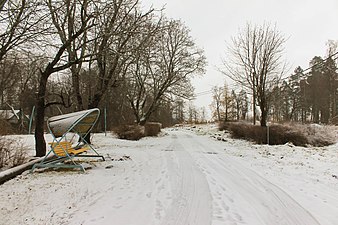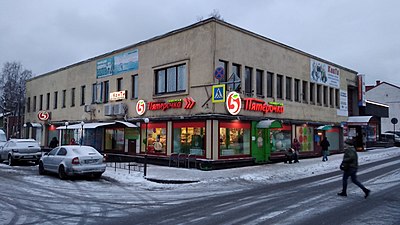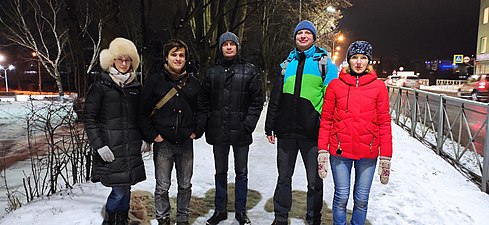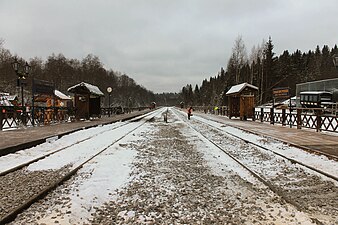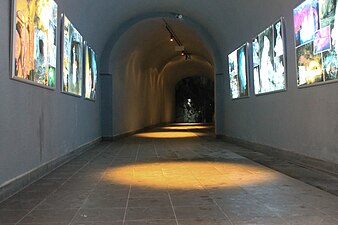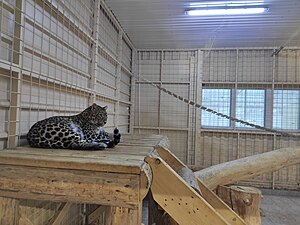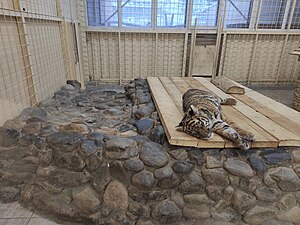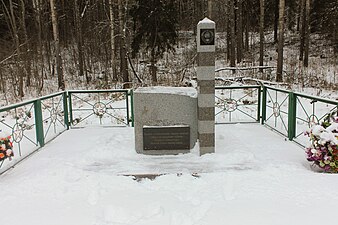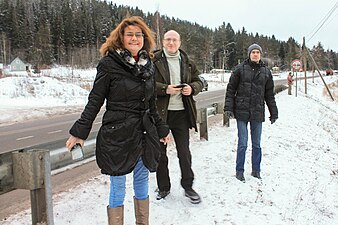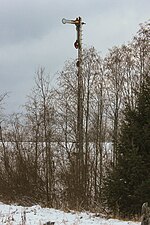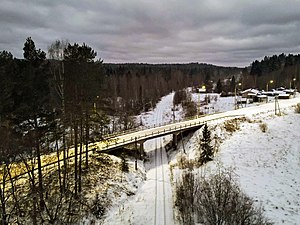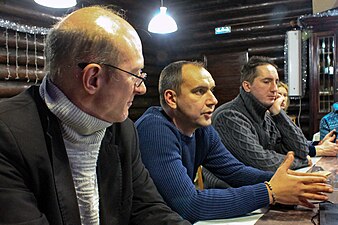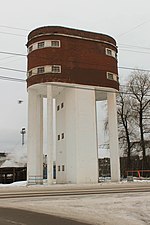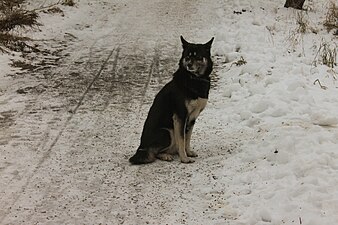Karelia Wiki Expedition of Petersburg Wiki Historians
Tuesday, March 2, 2021

| This article mentions Wikimedia Foundation, one of its projects or related people. Wikinews is one of Wikimedia Foundation projects. |
In the very end of the year 2020 the Wikimedia User Group called NWR-Hist made their another wiki expedition—this time to the Republic of Karelia, which is one of the declared areas of their interest. The event turned out to be the biggest in a row: it was 3 days long and gathered participants from several regions of Russian Federation who occupied 3 cars to travel accross the area making stops for sightseeing, photographing, studying and making consultations. For reports on previous events, see Russian Wikinews category "North-West Russia Wiki-Historians".
The event was held with the financial support from Wikimedia RU, so some of participants were hosted at a hotel, some of the transportation expenses were also compensated. With this support, all of the group visited the famous Ruskeala mountain park (central walk of the trip) and hade a dinner in the lake-side restaurant in the House of Composers historical building where common usergroup conference (central event of the trip) took place with Zoom connections with those who were absent.
The first group of 3 wikimedians started off from Saint Petersburg on 25 December at 9:30 AM and moved towards Karelia along the A121 'Sortavala' highway. The cultural heritage sites in the Leningrad Oblast's northern parts on this way were also very interesting for the group. So one of the stops was made in Priozersk, where one of the previous rambles took place in May 2019.
Shots from Leningrad Oblast
-
Ampiala mansion park
-
Ducks near the Korela Fortress greeting the just-arrived group
-
A monument to Rurik who is believed to die here
-
Military sanatorium near the Korela Fortress
-
The crew is waiting for the drone to land
-
Beryozovo: the mock border-guard point
In Priozersk, the crew visited former Juho Ampiala mansion which is the cultural heritage site but which is located outside main tourist routes (that's why there were almost no photos at Wikimedia Commons). The next stop was made at ancient Korela Fortress, main town's landmark, to photograph it from above using the drone. The last visited location in Leningrad Oblast this time was the mock "border outpost" (mainly children-oriented) at Beryozovo settlement. It was not in plans, but its look attracts passing-by people. It was closed, but available for taking pictures from outside.
At the border of Leningrad Oblast and the Karelia Republic, the crew was briefly stopped by the border guards. Later the expeditioners turned away from mainline A-121 road and started moving by local roads through historical Hiitola and Kurkijoki settlements, and also visited Lasanen settlement where "Oceanpribor" scientific base is located.
Lahdenpohja raion
-
A building at Kulikovo settlement, supposedly a barrack for railroad workers
-
Hijtola City Hall built in so-called Finnish Functionalism style
-
Hiitola railway station
-
Lasanen settlement, Okeanpribor scientific enterprise
-
Kurkijoki historical museum formerly known as Räsänen House
-
Kurkijoki inhabitants paid no attention to the travellers
The heavy northern snowfall hampered photographing and made the travelling speed much lower (despite the car being off-road). So the crew reached Lahdenpohja only in the brink of sunset. Nevertheless, the participants tried to make some photos both from the ground and from above. Also they made short walk around the town center, visiting the main places of interest. On the picturesque shore, an old cast-iron cannon was found and photographed immediately for the thematic Wiki collection maintained by active Wikipedian Leonid Makarov.
Lahdenpohja town
-
Taskinen's mansion in Yakkima
-
Yakkima railway station from drone
-
A Finnish power distribution tower at Lahdenpohja
-
Another one, in Finnish Functionalism style
-
A typical Finnish Functionalism example from 1930s — the central Lahdenpohja department store
-
Aerial view of Lahdenpohja and Ladoga's Jakimvaara bay
-
The historical cast-iron cannon at the coast promenade
As the sunset came, further photographing became senseless, so the travel part from Lahdenpohja to Sortavala was accomplished without further stops. Upon arrival, Saint Petersburg wikimedians joined Petrozavodsk (Karelia's capital) wikimedians who arrived an hour before. They met near the Sortavala's central landmark, the monument to a Rune Singer at the Väinämöinen square. The whole group directed to the town's railway station and discussed transportation in region. They also watched steam locomotives at Sortavala depot, where 3 active ones are in operation and 1 is used as monument but is also operable. This makes Sortavala the most "steamed" location in Russian Northwest after Saint Petersburg where are also a number of steam locomotives are available.
Evening in Sortavala
-
Rune Singer monument at Väinämöinen square (a good place to meet)
-
Wikimedians from Saint Petersburg and Petrozavodsk meets near Karelian bridge
-
The vivid discussion about railroads was featured with immediate physical examples
-
Berg House in Sortavala
The travellers also visited the landmark called Berg House, which is a cafe newly-built in 2020 as a recreation of historical house lost in fires in 1929 and 1970. The interiors of this cafe are decorated with historical photos of Sortavala: while examining them, the crew was waiting for the arrival of the second group from Saint Petersburg, headed by Wikimedia RU director Vladimir Medeyko.
The second day was intended to be intense. After gathering near the hotel called 'Sortavala', the wikimedians went to the central point of the whole expedition — the Ruskeala mountain park. It's located about 30 kilometers to the north and is popular among tourists. It's the former marble quarry for that was transformed nowadays into the dedicated landmark. Another aim was to meet the dedicated train called "Ruskeala Express" that drives directly from Moscow through Sortalava. From Sortavala to Ruskeala it drives under a steam engine. Its terminus at Ruskeala is specially re-constructed for it and also it has the specially designed interior.
Along their way to Ruskeala, the group of expeditioners headed by Nikolay Bulykin (user:Красный), moved away of the planned path to photograph the neighboring railway station of Kaalamo settlement. It was built in 1980s and is not considered historical nowadays, but is also interesting for wikimedians as an architectural and infrastructural object.
Kaalamo
-
Kaalamo is a busy nodal station serving quarries, so many freight trains usually are present
-
Kaalamo railway station brick building suprisingly looks like wooden house
-
One of truly historical buildings in Kaalamo
Returning from Kaalamo to Ruskeala, the basic crew found out that the other members of the expedition were already gathered at the meeting point, were not very consent with the halt, so the excursion began right out. Wikimedians passed through the short entrance tunnel of the Mine №2 to enjoy the spectacular view of the Big Marble Quarry. After that, they moved on to the railway station to meet the steam train mentioned above. The station is converted from industrial terminus used for transportation of excavated stone. It was being modernized at the time — the turntable for steam engines was in final stages of preparation. Its purpose is to allow steam engines to turn around without need to use second locomotive.
Overground Ruskeala
-
Expeditioners in front of Mine №2
-
Marble kilns left from the former lime plant
-
Ruskeala Mountain Park railway station
-
The turntable for steam engines, allowing them to turn around without need to use a second one
-
Thorough wikimedians noticed an obvious spelling error in an old-fashioned spelling of the warning plaque (reads "Beware of train!")
But it wasn't the lucky day for the railroad fans: the engine got broken in the forests near the Kaalamo and stuck in the way with all its passengers, the station workers were in alert. The sad railway-keen crew members left off and all of the posse headed to the most remarkable (and expensive) part of the trip — "Underground Ruskeala". This is an optional excursion through decorated and illuminated tunnels and caves left from marble excavation. The culmination of the path is the "Big Cavern" — the big flooded cave with fallen top. There are floating walkways around it for tourists, sections of the cave are illuminated and one section have musical accompaniment featuring folk songs in Karelian language. This allows to evaluate the picturesque view of the cave from inside where forest on the ground is clearly visible and makes a dimensional impression.
Underground Ruskeala
-
Old quarry trolleys: these are were brought from Urals region, not taken at the place
-
The entrance to the Underground Ruskeala
-
The gallery at the entrance depicting its history
-
The tunnels are paved with concrete with draining grooves aside
-
Ruskeala's "Big Cavern"
-
Colored marble pieces are visible on the walls
After the culminating excursion the part of the crew who arrived from Petrozavodsk separated and headed towards Russia's border, to the Kirkkolahti town on the coast of the lake Janisjarvi where the Karelian Zoo is located, the biggest zoo in Karelia. On the way, the travellers made photos of remnants of the hydro-power plant Jakkima near a river-rapid called Sahankoski on the river of Tohmajoki — this is a sample of Finnish industrial architecture of the early 20th century. The plant building is partly demolished, but there is a main part which is in operation as the transformer substation too.
Kirkkolahti is about 30 minutes way from Ruskeala. To get there, one have to turn from the main road (it goes to Värtsilä border checkpoint) to the secondary road, and the turn is marked with a giant figure of a moose, so the turn is hard to skip. By its size — 30 hectares — the Karelian Zoo overcomes all of the neighboring zoos: Korkesaari in Helsinki (22 hectares), Saint Petersburg zoo (7,2 hectares), Kitee (10 hectares), Ranua, at Karelian capital Petrozavodsk and at Syamozero lake. But the collection of species is not so impressive. 500 animals and 150 birds are present. The most paddocks are open-air, so cold Karelian winters limit the species suitable for such keeping. Mainly these are artiodactyls — alpaca, guanaco, yaks, bisons, llamas, deers etc. Also there are two hangars for keeping warm-loving animals including predators — puma, leopard, tiger, lynx — and a hangar for birds with open-air and indoor parts — owls, peacocks, pheasants etc. Some of the animals may be feed by carrot which is sold nearby.
Northern part of Sortavala raion
-
Sahankoski power plant
-
Entrance of the zoo
-
Panther is a rare animal here
-
There are more cats
-
They have tigers here!
-
A big collection of birds
-
Tyto alba (white owl)
-
Kirkkolahti is a gulf witin Jänisjärvi lake
On the lake shore near the zoo there is a very expensive tourist complex called "Black Stones". The Jänisjärvi lake is interesting for its round form, which is considered to have a meteorite origin. But the lake's gulf Kirkkolahti is too vast to allow a visitor to evaluate the size of the whole lake. The expedition noticed the "slush" at the lakes's surface.
The rest of the crew headed to the village of Läskelä situated at the crossing of Sortavala road and Janisjoki river, where another hydro power plant is located. It is adjacent to a former paper factory of the late 19th century. On the way, the crew made a stop at Rautakangas settlement to photograph the monument to border guards defending the area in 1941 during Finnish attack. The another stop was made at Kirjavalahti gulf which is the northernmost Lake Ladoga point.
Kirjavalahti and Läskelä
-
The monument to the border guards defending the area during USSR's Great Patriotic War
-
At Kirjavalahti gulf
-
XIX century Läskelä paper plant at Janisjoki river
-
Läskelä railway station has a rare thing, a semaphore that is working, one of the last in Russia
After visiting Läskelä, the wikimedians went to Rautalahti settlement, where one of them, Wiki user Charoplet, who lives in the nearby Harlu settlement, invited the crew to the building of the old Finnish school called Heinäjoki. It had been abandoned for years, but he bought and keeps restoring it these days. This is a 2-storey building in Functionalism style, built in 1926 and is now a single building left from the whole village of Heinäjoki which is now part of Rautalahti.
Harlu and Rautalahti
-
A121 'Sortavala' highway heading towards Rautalahti
-
Wikimedians visit Heinäjoki elementary school. It was functional until 2001 and abandoned since then until 2019
-
Wikimedians operate their drone before dusk is come
-
Zavodskaya street in Harlu
-
Railway bridge in Harlu
After that, the posse went to Harlu, while trying to catch some remaining daylight suitable for photographing. In the end of December, the sunset there is at 15:30 (while they left Läskelä at 15:00), so normal photographing was again barely available. Despite that, some photos were made, pictured some of the objects were not previously available at Wikipedia among them. Later, the whole expedition went to the final point of the second day: the "hunting castle" of the House of Composers at Kirjavalahti shore also known as Jaskelajnen Dacha. The building was built in 1937 by famous Finnish architect Pauli E. Blomstedt. This historical place was intended to be the location of the Conference of the NWR-Hist Wikimedia User Group aimed at summarizing its achievements of the 2020 and generating annual reports in Russian and English languages.
After a dinner, the conference started, with other user-group members (who couldn't come) connected distantly via Zoom software. These include Farhad Fatkullin, Andrey Petrov, Ekaterina Borisova and others. There were many topics to discuss, the main of them were:
- The welcome speech by head of Wikimedia RU Vladimir Medeyko;
- Report by Dmitry Zhukov about Wiki edit-a-thon called Discover Russia. Novgorod Lands;
- Report by Nikolay Bulykin about the usergroup 2020 achievements and 2021 plans, transformed into a wide discussion.
Conference at Kirjavalahti
-
The beginning
-
Vladimir Medeyko, Dmitry Zhukov, Pavel Chernikov (Charoplet)
-
The full video of the conference in Russian language (1 hour)
-
The Jaskelajnen Dacha seen from outside
After the last night in Sortavala, the another try of photographing the "Ruskeala Express" steam-train was planned, but only Petrozavodsk part of the crew managed to get to the railway station in time, while the Saint Petersburg part photographed the picturesque train which was moving along the Sortavala dam across the Vakkolahti gulf from distant Karelian bridge.
Ruskeala Express
-
Video of the departure
-
П36-0032 steam engine at Sortavala depot
-
Over the dam
After that, Petrozavodsk group went to Lahdenpohja town where a private military museum is located. This is the former military base called Huuhkanmaki where some former Finnish military installations are located. There are barracks in Finnish Functionalism style built by architect T. E. Elovaar in 1933. Nearby, an underground bunker inside a rock is located, which meant to be a reserve military headquarters. In USSR it was used as the military warehouse and nowadays it's a museum called "Eagle Owl Mountain" which is renovated, illuminated, heated and ventilated. There are two exhibition parts: historical part dedicated to Karelia, featuring many Karelian minerals, and the second one is dedicated to the Winter War.
"Owl Mountain" museum complex
-
Barracks seen from the mountain
-
Open-air vehicle exhibit
-
Food supply vehicles
-
The exhibition within the bunker
-
Exhibit showing military medical supplies
"Eagle Owl Mountain" also features some mountain pathways, where the Petrozavodsk part of the crew walked. After that they returned to Sortavala for a dinner, say goodbye to other part and started off for their home city. The Saint Petersburg part members walked around Sortavala to enjoy and photograph the views and places. They split in two groups so they could photograph more landmarks.
Sortavala walks
-
Water tower at Sortavala depot, the last Finnish building here built in 1942
-
Central Sortavala as seen from drone
-
Typical wooden building from 19th century in the city southwest
-
Local fauna
-
And some details, like this Finnish square manhole
As the results of the whole event, the crew achieved all its goals: arranged organizing and reporting, examined a number of landmarks and other interesting places, gathered the large collection of photos and videos of the region. This is all necessary for forming Wikivoyage guides and databases, filling multi-language Wikipedia, Wikimedia Commons and other Wikimedia projects (such as Wikinews) with new content. All of the photographs and videos can be, as usual, found at the Commons category Wikimeetup in Sortavala 2020-12-25/27. Find out more about the Wikimedia User Group: North-West Russia Wiki-Historians User Group at Meta-Wiki (in 9 languages). And here is the 2020 annual report in English.
| Next story: Lampovo Wiki Expedition of Petersburg Wiki Historians |
| Previous story: Zelenogorsk Wiki Car Expedition for Railways and Swamps |
| See also: Russian North-Western Wiki Historians Wikimedia User Group celebrates Wikipedia Birthday and presents annual activity report |
Sources
править
Комментарии

Если вы хотите сообщить о проблеме в статье (например, фактическая ошибка и т. д.), пожалуйста, используйте обычную страницу обсуждения.
Комментарии на этой странице могут не соответствовать политике нейтральной точки зрения, однако, пожалуйста, придерживайтесь темы и попытайтесь избежать брани, оскорбительных или подстрекательных комментариев. Попробуйте написать такие комментарии, которые заставят задуматься, будут проницательными или спорными. Цивилизованная дискуссия и вежливый спор делают страницу комментариев дружелюбным местом. Пожалуйста, подумайте об этом.
Несколько советов по оформлению реплик:
- Новые темы начинайте, пожалуйста, снизу.
- Используйте символ звёздочки «*» в начале строки для начала новой темы. Далее пишите свой текст.
- Для ответа в начале строки укажите на одну звёздочку больше, чем в предыдущей реплике.
- Пожалуйста, подписывайте все свои сообщения, используя четыре тильды (~~~~). При предварительном просмотре и сохранении они будут автоматически заменены на ваше имя и дату.
Обращаем ваше внимание, что комментарии не предназначены для размещения ссылок на внешние ресурсы не по теме статьи, которые могут быть удалены или скрыты любым участником. Тем не менее, на странице комментариев вы можете сообщить о статьях в СМИ, которые ссылаются на эту заметку, а также о её обсуждении на сторонних ресурсах.
